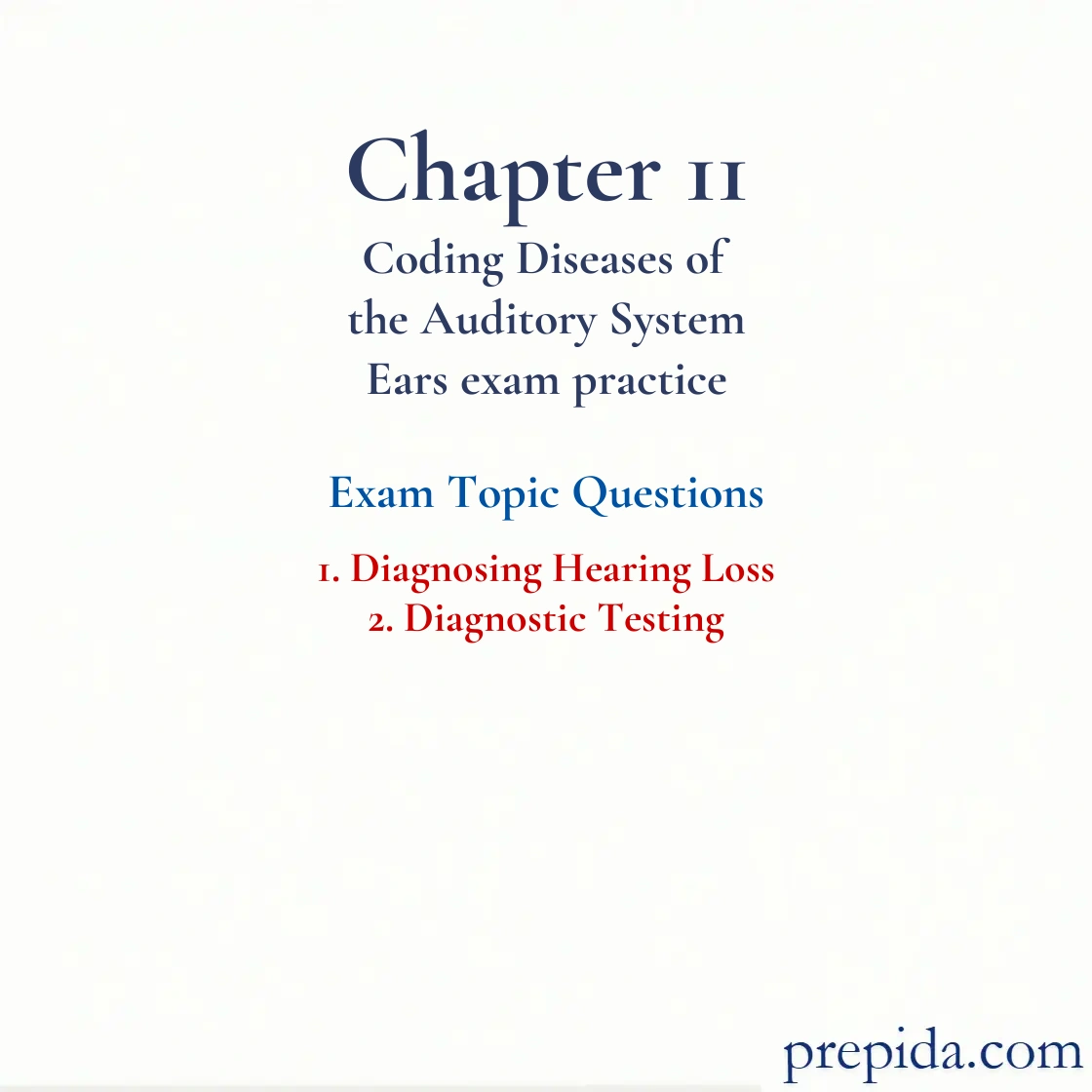
Which of the following can contribute to hearing loss?
- Genetics
- Congenital anomalies
- Pathogens
- All of these
Genetics, congenital anomalies, and pathogens can all lead to hearing loss.
Other Specified: Additional information that the physician specified and isn’t included in any other code description.
Which of the following diseases can cause fetal hearing loss during pregnancy?
- Herpes
- Rubella
- Toxoplasmosis
- All of these
Herpes, rubella, and toxoplasmosis can all cause fetal hearing loss during gestation.
Other Specified: Additional information that the physician specified and isn’t included in any other code description.
Which of the following is not a function of cerumen?
- Protecting the skin of the ear canal
- Protecting the middle ear from bacteria
- Enabling cleaning and lubrication
- Transferring sound waves from the eardrum to the incus
The malleus transfers sound waves from the eardrum to the incus.
Anatomical Site: A specific location or part of the human body.
Which of the following medications might cause ototoxic hearing loss?
- Gentamicin
- Cisplatin
- Carboplatin
- All of these
Gentamicin, cisplatin, and carboplatin can all cause ototoxic hearing loss.
Other Specified: Additional information that the physician specified and isn’t included in any other code description.
What are the correct codes for ototoxic hearing loss, right ear, after taking gentamicin?
- H91.01, T36.5X5A
- H91.02, T36.5X1A
- H91.01, T36.5X5
- H91.02, T36.5X1
H91.01 is the code assigned for ototoxic hearing loss of the right ear due to gentamicin. H91.01: Index>deafness>ototoxic>see subcategory H91.0-. T36.5X5A: Drug index>gentamicin>adverse effect>initial encounter. See instructional note Use additional code for adverse effect under code H91.01.
Adverse Effect: An unexpected, bad result; also known as an adverse reaction. The harm a patient experiences by a medication that has been prescribed by a health care professional and taken as instructed; an unexpected reaction to a drug taken for therapeutic purposes.
What is the correct code for mixed conductive and sensorineural hearing loss, unilateral, left ear, with unrestricted hearing on the contralateral side?
- H90.42
- H90.5
- H90.72
- H90.8
H90.72 is the correct code for mixed conductive and sensorineural hearing loss, unilateral, left ear, with unrestricted hearing on the contralateral side. H90.72: Index>deafness>mixed>unilateral>left.
Diagnosis: A physician’s determination of a patient’s condition, illness, or injury.
What is the correct code for high-frequency deafness, right ear?
- H91.90
- H91.91
- H91.92
- H91.93
H91.91 is the code assigned for high-frequency deafness, right ear. H91.91: Index>deafness>high frequency>right.
Diagnosis: A physician’s determination of a patient’s condition, illness, or injury.
Which of the following tests is used to evaluate the patient's ability to hear sounds at various decibels?
- Basic screening test
- Tuning fork test
- Pure tone hearing test
- Frequency test
The pure tone hearing test is used to evaluate the patient's ability to hear sounds at various decibels.
Callin Collin is seen in the office today for bilateral hyperacusis and bilateral perceptive hearing loss. What are the correct codes?
- H93.231, H90.0
- H93.232, H90.3
- H93.233, H90.3
- H93.239, H90.8
The correct codes for bilateral hyperacusis and bilateral perceptive hearing loss are H93.233 and H90.3. H93.233: Index>hyperacusis>bilateral. H90.3: Index>deafness>sensorineural>bilateral.
Which of the following tests is usually performed by an audiologist?
- Basic screening test
- Tuning fork test
- Pure tone hearing test
- Frequency test
The pure tone hearing test is usually performed by an audiologist.
Max Mawell was seen in the office today for left cochlear otosclerosis and recurrent cholesteatoma of a postmastoidectomy cavity of the right ear. What are the correct codes?
- H80.21, H95.01
- H80.21, H92.03
- H80.22, H95.01
- H80.22, H95.02
The correct codes for left cochlear otosclerosis and recurrent cholesteatoma of a postmastoidectomy cavity of the right ear are H80.22 and H95.01. H80.22: Index>otosclerosis>cochlear>left. H95.01: Index>complications>postmastoidectomy>recurrent cholesteatoma>right.
Hypertension: High blood pressure, usually a chronic condition; often identified by a systolic blood pressure above 140 mm/Hg and/or a diastolic blood pressure above 90 mm/Hg.
Which unit of measurement determines the intensity, or loudness, of sound?
- dB
- Hz
- Db
- hZ
Decibel (dB) is the unit of measurement used to determine the intensity, or loudness, of sound.
Which of the following tests is used to evaluate how well words and other sounds are heard at varying volumes?
- Basic screening test
- Tuning fork test
- Pure tone hearing test
- Frequency test
The basic screening test is used to evaluate how well words and other sounds are heard at varying volumes.
What does the abbreviation PFSH stand for?
- Personal, family, and social history
- Patient, family, and social history
- Past, family, and social history
- Palliative, family, and social history
PFSH stands for the complete patient, family, and social history.
Which of the following tests is used to evaluate whether the eardrum has been damaged?
- Basic screening test
- Tuning fork test
- Pure tone hearing test
- Frequency test
The tuning fork test is used to evaluate whether the eardrum has been damaged.
Anatomical Site: A specific location or part of the human body.
Which unit of measurement determines the frequency or pitch of sound?
- dB
- Hz
- Db
- hZ
Hz or hertz is the unit of measurement used to determine the frequency or pitch of sound.